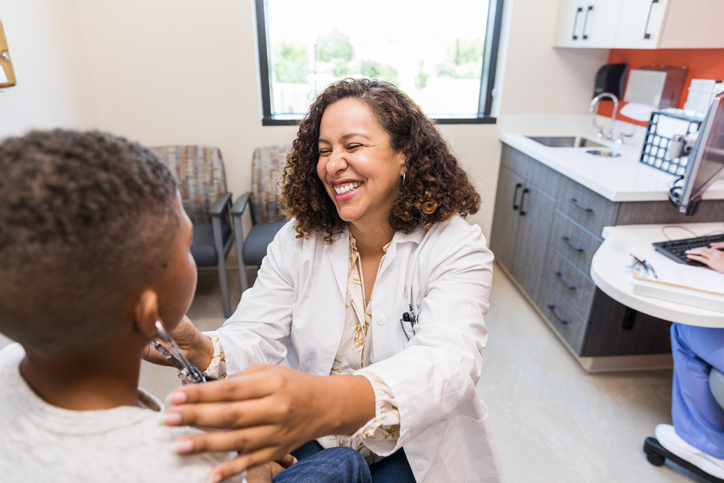Rural Nursing for APRNs: Tips for Practice
Written by:
University of Tulsa
• Mar 22, 2024

For many small towns and rural communities experiencing a shortage of physicians and other health care workers, advanced practice registered nurses (APRNs) who choose to specialize in rural nursing are making a world of difference.
Acting as primary care providers, rural nurses work closely with their patients and create programs and resources that provide health and wellness information to the community. Pursuing an advanced education, such as that provided by a Master of Science in Nursing (MSN) program, offers individuals interested in rural nursing the opportunity to build a fulfilling career caring for people living in communities that need help.
What Is Rural Nursing?
What rural nursing is focused on is providing care to patients who live in remote and geographically or culturally isolated areas. For many of these communities, their location and smaller population can make accessing adequate health care services challenging.
Nationwide, both rural and urban communities are facing a shortage of primary care providers and physicians. In rural communities, this shortage can be particularly challenging, as patients may experience long wait times or be forced to travel long distances to access routine care, emergency care, or specialized care.
In these communities, APRNs or similarly qualified professionals who are certified to provide primary health care services have become essential to maintaining a functioning health care system. Able to bridge the gap between physicians and other health care specialists, APRNs can ensure that patients have access to routine checkups and care services, referring them to other providers as needed and providing the community with wellness resources on a day-to-day basis.
Nursing in Rural Areas
One of the key differences between nursing in rural areas and nursing in many urban and suburban settings is the population’s access to health care options. Often underserved, people living in many small communities struggle with accumulating enough funding to attract skilled health care professionals to their area. Over the long term, this can make it challenging for them to maintain or improve their overall health and wellness.
A day in the life of nurses who choose to work in rural communities can look different from that of nurses who work in cities as well. Often working in smaller care facilities, occasionally with less advanced equipment, and with limited staff, nurses may be required to take on additional duties outside their normal responsibilities.
Nursing in rural areas often requires nurses to work closely with other health care professionals for the facility to function. This can help promote teamwork and a sense of unity that is not always found in urban settings. Providing nurses with the opportunity to not only build relationships with their co-workers but also with their patients, nursing in rural areas can be a great opportunity for nurses who value community, allowing them to be a part of their patients’ lives and celebrate their successes.
Health Professional Shortage Areas (HPSA)
Many rural communities are identified by the federal government as health professional shortage areas (HPSAs). The HPSA designation was created to help combat the lack of health care resources in underserved communities nationwide. People facing health disparities in rural communities often live in areas that fall under this designation. Communities can be given the HPSA designation for a variety of reasons, each one presenting its own set of challenges.
Medically Underserved Areas (MUAs)
The term medically underserved area refers to geographic areas that are experiencing a shortage of primary care service providers. MUAs can refer to areas of all sizes, from entire countries to civil divisions or individual counties.
Medically Underserved Populations (MUPs)
Referring to a subset within a population as opposed to a geographic area, a medically underserved population is a group of people experiencing a lack of access to primary care services. These subsets include categories such as Medicaid-eligible groups, people experiencing homelessness, Native American communities, and migrant workers.
Geographic HPSAs
A geographic HPSA refers to the entire population in an established geographic area that is facing a shortage of or lack of access to health care services.
Population HPSAs
Similar to an MUP, population HPSAs refer to the specific subset within a population that has limited access to services. This includes those lacking access to both primary care services as well as other necessary resources within a specific or established geographic area.
Facility HPSAs
Facility HPSAs fall under the category of either facility HPSA or automatic facility HPSA. Facility HPSAs include public and nonprofit medical facilities, mental health institutions, and correctional facilities that do not have adequate access to care services or resources. Automatic facility HPSAs are facilities that are federally or state designated and do not need to apply for an HPSA designation.
Health Disparities in Rural Communities
Health disparities in rural communities are caused by a multitude of factors. From the remoteness of their locations and challenges accessing health care equipment or funding, to shortages of care providers and the lack of informed health care representatives equipped to serve culturally isolated communities, rural residents face a number of difficulties when it comes to maintaining their health.
These difficulties often mean that the resources smaller communities have are stretched thin. This can result in rationing available equipment and resources, longer wait times for emergency services, care providers taking on additional responsibilities, and patients needing to travel long distances to access specialized care, all of which can lead to health disparities in rural communities.
Current Health Care Shortages
Across the country, communities of all sizes are struggling with a shortage of nurses, physicians, and other skilled health care professionals. According to the American Association of Colleges of Nursing, the nationwide shortage of nurses is expected to intensify, leading to a lack of access to care and potentially harmful consequences for patients seeking care.
In the case of certain APRNs, including nurse practitioners, the U.S. Bureau of Labor Statistics projects that approximately 29,200 will be required each year through 2031 to fill open positions. Combined with the projected shortage of between 37,800 and 124,000 physicians within 12 years, as reported by the Association of American Medical Colleges, the country may soon be in dire need of skilled health care professionals.
These shortages may be exacerbated in already underserved areas and lead to increased health disparities in rural communities. With many nurses already choosing to work in urban health care facilities that have better funding and a greater potential for career advancement, convincing nurses to choose to work in a rural facility may prove to be challenging.
Disparities and Rural Nursing
The nursing profession can be both challenging and fulfilling, a dynamic that is accentuated for rural nurses. Depending on the type of medical facility and the care needs of its community, there are both advantages and disadvantages for those who choose rural nursing.
Advantages of Nursing in Rural Areas
Nursing in a rural area can require a very different approach compared with nursing in an urban area or suburb. In remote communities with small population sizes, nurses are more likely to act as primary care providers and have long-term or repeat patients. This allows nurses to build a rapport with their patients, giving them the opportunity to care for them and their families throughout their lives and build a sense of community within their practice.
Additionally, in smaller populations, rural nurses have the opportunity to give back to their community, providing health and wellness resources and education to groups of people as needed. Through community gatherings, informative programs or care resources, and the ability to care for all ages of patients and families, nurses can see their work have a positive impact over the long term.
Disadvantages of Nursing in Rural Areas
While it can be rewarding, nursing in rural areas also presents its own unique set of challenges. With smaller population sizes often comes less funding or resources. This can lead to a shortage of equipment, short staffing with care providers stretched thin, limited hours of operation, or a lack of access to emergency care.
In many rural facilities, health care workers are required to take on additional responsibilities in order for the practice to function. This can mean nurses are taken away from their regular nursing duties to complete tasks that would normally be handled by other team members in larger organizations. Whether those tasks are administrative or hands-on, the extra work can take a toll on nurses and make it more difficult for them to provide optimal care to patients.
Also, with many facilities lacking the funding and resources to invest in care services or upgrade their equipment, nursing in rural areas can be practiced at a less advanced level than in many urban or suburban communities.
How Nurses Make a Difference in Rural Oklahoma
With much of rural Oklahoma qualifying as a medically underserved area, due to both low-income populations and geographically isolated populations, the physician and nursing shortages are felt acutely across the state. A rancher in a corner of Oklahoma might need to travel halfway across the state for a simple X-ray or a preventive screening.
Due to the severity of health care shortages throughout the rural areas of Oklahoma, increasing the number of nurses interested in pursuing a rural nursing career may be the best hope for increasing health care access in these communities. With an advanced degree, such as a Master of Science in Nursing (MSN) or a Doctor of Nursing Practice (DNP), nurses who have qualified to become APRNs can play an essential role in bringing primary care services to these small communities.
By working in conjunction with physicians and other health care professionals, skilled nurses are able to mitigate some of the health care disparities in rural communities and provide remote populations with needed routine care services. While many patients may still be required to travel to reach more advanced levels of care, nurses choosing to work in rural areas can make a positive difference in the lives of patients in rural communities.
How to Become a Rural Nurse
The standard for education, certification, and workplace experience required to work in rural nursing can be extensive. In many cases, health care facilities and practices will look to nurses who are certified as advanced practice registered nurses, demonstrating that they are able to work independently and take on additional responsibilities without requiring the supervision of a physician.
APRN Education and Qualifications
Advanced practice registered nurses are highly trained nurses working as nurse practitioners, nurse midwives, nurse anesthetists, and clinical nurse specialists. APRNs have earned an advanced nursing degree, such as an MSN or DNP, and passed board certification and licensure examinations as required by their state. For nurses considering nursing in rural areas, advancing their level of education, gaining work experience, and completing additional license or certification requirements can make them desirable candidates for APRN roles in many underserved communities.
Prior to becoming an APRN, nurses must have earned their Bachelor of Science in Nursing (BSN) or Associate Degree in Nursing (ADN) and passed the National Council Licensure Examination for Registered Nurses (NCLEX-RN) to become a registered nurse (RN). The entire process may take nurses six to eight years or longer to complete, depending on which degree path they choose and whether they choose full- or part-time study.
The process to become an APRN working in rural nursing can look like this:
- Earn a Bachelor of Science in Nursing or Associate Degree in Nursing.
- Pass the NCLEX-RN, and become an RN.
- Earn a Master of Science in Nursing or Doctor of Nursing Practice; these programs often require students to specialize.
- Gain work experience, and complete supervised clinical hours.
- Become board licensed and certified, as required nationally or by state regulations.
Rural Nursing Career Outlook
Nursing in rural areas can be demanding. However, the long-term job outlook for those who pursue a career in nursing is positive. According to the BLS, employment of certain APRNs including nurse practitioners is projected to grow by 38% between 2022 and 2032, which is significantly faster than the national average job growth projected for all occupations as well as the 6% growth projected for RNs.
As mentioned above, about 29,000 job openings for these APRNs are projected to be open each year on average over the next decade. Between the high demand for nurses in rural areas and the rate at which many practitioners are retiring, pursuing rural nursing may prove to be a dependable and profitable career choice.
Tips for Rural Nurses
With facilities often required to make do with limited resources or a smaller workforce, rural nursing can be a game of multitasking and problem-solving. Here are some tips to manage rural nursing successfully:
-
Make time for self-care: As with any kind of nursing, rural nursing requires treating patients with compassion, patience, and consideration. Doing so can take a lot of energy, making it essential that nurses take the time they need to care for themselves to avoid burnout. Whether that is focusing on their diet, making time for hobbies, or ensuring they have a support system to help them cope with stressful situations, prioritizing their well-being can make all the difference in a nurse’s ability to provide quality care.
-
Work together as a team: Smaller workforces mean that the better staff are able to work together, the more efficiently they can provide care. By taking the time to build rapport and positive relationships with other members of their health care team, nurses can more effectively coordinate patients’ care in high-pressure situations.
-
Continue education and pursue additional certifications or skills: The demands placed on rural nursing teams can be extensive. While nurses have the option to refer patients to other health care professionals, the more services they are qualified to provide, the better they are able to serve their communities. Additional certifications can cut down on the need to send patients to other facilities and streamline care.
-
Embrace living in a small community: Successful health care outcomes often correlate to patients being willing to follow care directives. Building a relationship with patients in their community can be an opportunity for nurses to build trust with their patients and encourage them to invest in their care. Additionally, embracing the community can be a great form of self-care for nurses, helping them find new things they enjoy in their everyday lives.
-
Build a network of care professionals: Nursing in rural areas can involve working with limited resources or medical equipment. For patients requiring services outside of routine care, nurses may need the assistance of other health care professionals or to refer their patients to specialists. By building a strong network of care providers with different skill sets, nurses can better direct the care of their patients, streamlining the process and mitigating costs for their patients.
Make a Positive Impact in Your Community as a Rural Nurse
Many rural communities across the country are facing both a lack of access to health care services as well as a shortage of skilled professionals able to provide them. In many of these communities, APRNs who are qualified to deliver primary care can make a significant difference.
By enrolling in a well-rounded advanced degree program, such as the Master of Science in Nursing program from The University of Tulsa, individuals interested in rural nursing can prepare themselves with the knowledge and skills they’ll need to act as primary care providers for their patients. Featuring one-on-one support from an accomplished faculty, the opportunity to choose between four specialty tracks, and a curriculum that is shaped around current industry needs, the MSN from The University of Tulsa was designed to provide you with all the tools you need to succeed. Explore how you can make a positive impact in your community as a rural nurse.
Recommended Readings
How to Become a Chief Nursing Officer
The Nurse Practitioner Job Outlook: Why NPs Are in Demand
Sources:
American Association of Colleges of Nursing, Nursing Shortage Fact Sheet
American Association of Medical Colleges, “AAMC Report Reinforces Mounting Physician Shortage”
American Nurses Association, Advanced Practice Registered Nurse (APRN)
American Nurses Association, “How to Go From Registered Nurse (RN) to Nurse Practitioner (NP)”
Indeed, “How to Become an Advanced Practice Registered Nurse (APRN)”
Johnson & Johnson, Rural Nurse
NBC News, “Rural Hospitals Losing Hundreds of Staff to High-Paid Traveling Nurse Jobs”
Oklahoma State Department of Health, Data and Reports — Health Professional Shortage Areas (HPSA)
U.S. Bureau of Labor Statistics, Nurse Anesthetists, Nurse Midwives, and Nurse Practitioners


